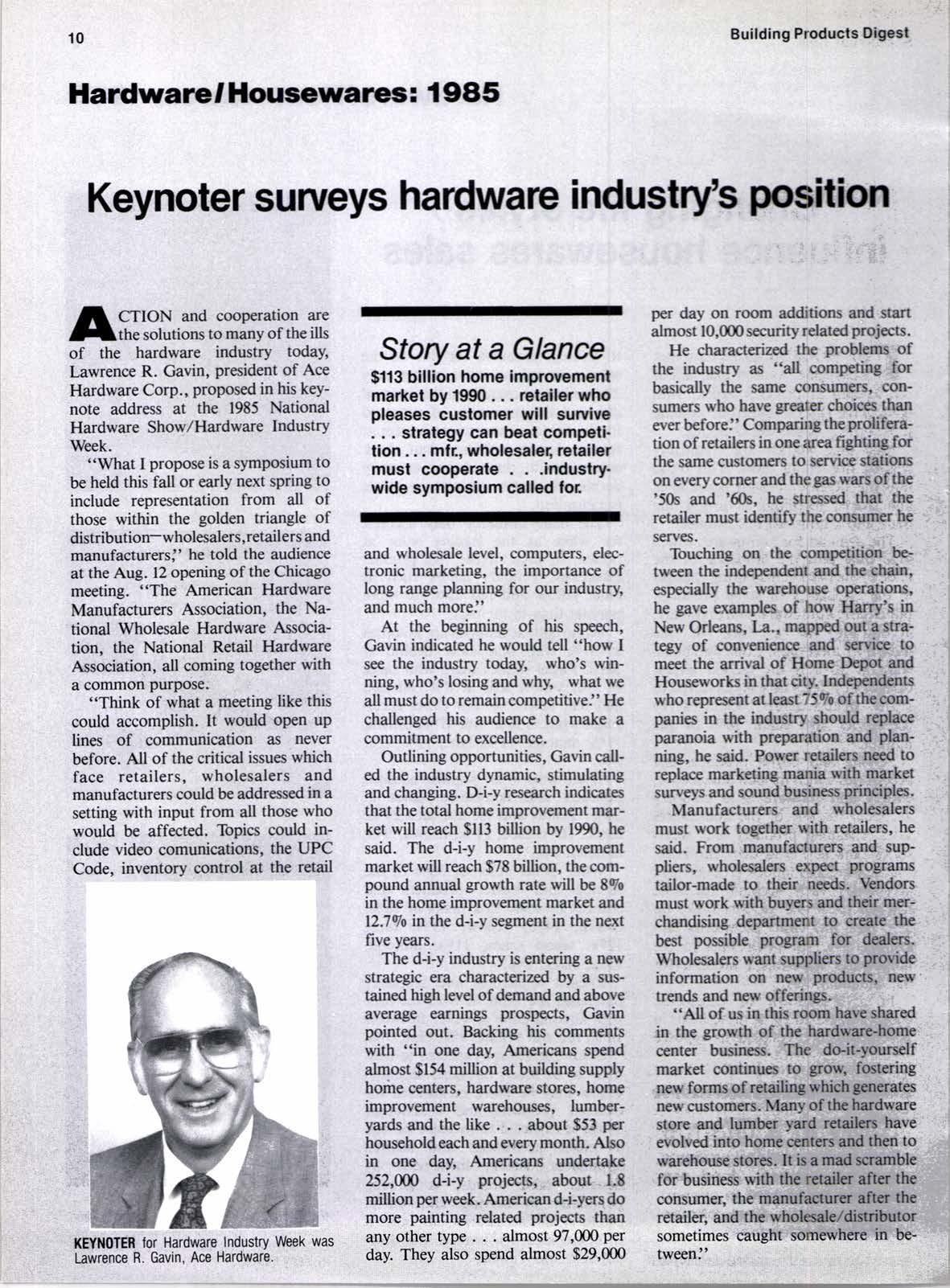
2 minute read
Keynoter surueys hardware industry's position
A crtoN and cooperation are llttre solutions to many of the ills of the hardware industry todal', Lawrence R. Gavin, president of Ace Hardware Corp., proposed in his keynote address at the 1985 National Hardware Show/Hardrvare Industr-v Week.
"What I propose is a symposium to be held this fall or early next spring to include representation from all of those within the golden triangle of distribution-wholesalers, retailers and manufacturersi' he told the audience at the Aug. 12 opening of the Chicago meeting. "The American Hardrvare Manufacturers Association, the National Wholesale Hardware Assoctation, the National Retail Hardware Association, all coming together with a common purpose.
"Think of what a meeting like this could accomplish. It would oPen uP lines of communication as never before. All of the critical issues which face retailers, rvholesalers and manufacturers could be addressed in a setting with input from all those uho would be affected. Topics could include video comunications, the UPC Code, inventory control at the retail
Story at a Glance
$113 billion home improvement market by 1990 retailer who pleases customer will survive . . . strategy can beat competition .. mfr., wholesaler, retailer must cooperate .industrywide symposium called for.
and uholesale lerel, computers, electronic marketing. the importance of long range planning for our industrl, and much more."
At the beginnin-e of his speech, Garin indicated he rrould tell "hon I see lhe industr) toda)', $ho's *inning, sho's losing and uh1', uhat ue all must do to remain competitir e." He challenged his audience to make a commitment to excellence.
Outlining opportunities, Gar in called the industr-v d1'namic, stirnulating and changing. D-i-y' research indicates that the total home improvemenl market uill reach Sll3 billion bv 1990, he said. The d-i-r home improrement market will reach 578 billion, the compound annual grouth rate rl'ill be 8ro in the home improvement market and 12.7To in the d-i-1' segment in the nert five 1'ears.
The d-i-l' industr)' is entering a nerr strategic era characterized by a sustained high level of demand and above a! erage earnings prospects, Car in pointed out. Backing his comments u'ith "in one day, Americans spend almost $154 million at building supply' home centers, hardrvare stores, home improvement uarehouses, lumberyards and the like . . . about S53 per household each and every month. Also in one day, Americans undertake 25}W d-i-y projects, about 1.8 million per week. American d-i-y'ers do more painting related projects than any other type . almost 97,000 per day. They also spend almost $29,000 per da1'on room additions and start almost 10,000 securitl related projects.
He characterized ttre problems of the industr)' as "all competing for basicalll' the same c()nsumers, consumers sho have greal.er choices than er er beforel' Comparirtg the proliferarion of retailers in one area lighting for the same cu\tomers to service stations on ever)' corner and thc gas s ars of the '50s and '6Os, he stressed that the retailer must identifl the consumer he ser\ es.
Touching on the competition betu.een the independent and the chain, especiallv the uarehouse op€rations, he -sare eramples of hon Harrl''s in Nerr Orleans, La., mapped out a strategl' ol conrenience and service to meet the arrival of Hrtme Depot and Houseuorks in that city'. Independents u ho represent at le ast l'5 ro of the companies in the induslry' should replace paranoia nith preparation and plannin-e, he said. Pou'er retailers need to replace marketing mania sith market sur\e)s and sound business principles.
\lanufacturers and rrholesalers must sork together uith retailers, he said. From manufacturers and suppliers, u holesalers elpect programs tailor-made to their needs. Vendors must \\'ork rvith buy'ers and their merchandising departmerrt to create the best possible prograrn for dealers. \\'holesalers uant suppliers to provide information on new products, neu trends and ne* offeriltgs.
"All of us in this room have shared in the gros'th of the harduare-home center business. The do-it-yourself market continues to grow, fostering nerv forms of retailing which generates ne$' customers. l!lan1' of the hard$'are store and lumber yard retailers have elolved into home centers and then to rvarehouse stores. It is a mad scramble for business with the retailer after the consumer, the manufacturer after the retailer, and the u'holesale/distributor sometimes caught sornewhere in between."










